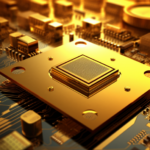When we think of aerospace, we often envision sleek aircraft soaring through the sky and spacecraft exploring the cosmos. What we might not immediately realize is that gold, a precious metal often associated with jewelry and wealth, is an unsung hero in the aerospace industry. Its exceptional properties and versatility make it a vital component in spacecraft, satellites, and aircraft. In this exploration of “Gold in Aerospace,” we’ll uncover the fascinating ways in which this precious metal contributes to the advancement of aviation and space exploration.

The Role of Gold in Aerospace
Gold’s use in aerospace can be traced back to the early days of space exploration and aviation. Its unique properties, including excellent thermal stability and electrical conductivity, have made it an indispensable material for various aerospace applications. Let’s delve into some of the key roles that gold plays in this industry.
1. Thermal Control: Gold is an outstanding reflector of infrared radiation, making it ideal for thermal control systems in spacecraft and satellites. It helps regulate temperatures and prevents overheating or freezing in the extreme conditions of space.
2. Electrical Conductivity: Gold’s exceptional electrical conductivity ensures reliable electrical connections and signal transmission in aerospace electronics, where performance and safety are paramount.
3. Reliability: In the unforgiving environment of space, reliability is crucial. Gold’s resistance to corrosion and oxidation ensures that components remain functional over extended missions.
4. Protection from Radiation: The space environment exposes spacecraft and satellites to harmful radiation. Gold-coated materials can act as radiation shields, protecting sensitive equipment and instruments.
5. Durability: The durability of gold means that it can withstand the harsh conditions of launch, the vacuum of space, and re-entry into Earth’s atmosphere without degradation.
Gold in Spacecraft and Satellites
Spacecraft and satellites are some of the most demanding applications in aerospace, and gold plays a critical role in their construction and operation.
1. Thermal Blankets: Gold-coated Mylar sheets are used as thermal blankets on spacecraft. These blankets help maintain a stable temperature by reflecting solar radiation and preventing excessive heat buildup.
2. Radiation Shields: In deep space missions, where cosmic radiation poses a significant threat to electronics and crew, gold is used as a radiation shield to protect sensitive instruments and equipment.
3. Solar Panels: Solar panels on spacecraft often incorporate gold to enhance their efficiency and durability. Gold is used to coat the electrical contacts on the solar cells, ensuring reliable power generation.
4. Electrical Contacts: The electrical contacts and connectors on spacecraft and satellites frequently have gold plating. Gold’s conductivity and resistance to corrosion make it essential for maintaining electrical connections in space.
5. Telescope Optics: Gold is used in the coatings of telescope optics on space observatories like the Hubble Space Telescope. The thin gold layers improve the reflectivity of mirrors and enhance the telescope’s performance.
Gold in Aircraft and Aviation
While gold is more commonly associated with space exploration, it also finds applications in the aviation industry, particularly in commercial and military aircraft.
1. Electrical Connectors: Gold-plated electrical connectors and contacts are used in aircraft systems to ensure reliable communication and operation. Gold’s corrosion resistance is critical for maintaining functionality in challenging environments.
2. Avionics: Avionics systems, including navigation, communication, and instrumentation, rely on gold for electrical connections. Gold’s conductivity and durability are essential in these critical applications.
3. Coatings: Gold coatings can be applied to aircraft windows to reflect sunlight and reduce glare, improving visibility for pilots and passengers.
4. Heat Shields: In high-speed aircraft and spacecraft, materials with high melting points, including gold, are used in heat shields to protect against the intense heat generated during re-entry into Earth’s atmosphere.
5. Sensors: Gold is used in sensors and detectors in aircraft systems, including radar and avionics equipment. Its electrical properties enable accurate data collection and transmission.
Gold in Space Exploration
Gold has played a crucial role in space exploration missions conducted by space agencies like NASA and ESA. Its contributions to scientific discovery and our understanding of the cosmos are remarkable.
1. Space Probes: Space probes like the Voyager missions and the Mars rovers have used gold-plated components to protect against radiation and extreme temperatures. These components have allowed these probes to operate far beyond their original mission durations.
2. Scientific Instruments: Scientific instruments on space telescopes and planetary missions often incorporate gold coatings and components. Gold’s reflectivity and durability are essential for collecting precise data in space.
3. Interplanetary Missions: Gold’s role in radiation shielding has been critical in interplanetary missions, such as the Mars Science Laboratory (Curiosity rover). Gold-coated materials protect delicate instruments from harmful radiation during the journey to other planets.
4. Space Observatories: Space observatories like the Hubble Space Telescope use gold-coated mirrors to enhance their imaging capabilities. These mirrors allow astronomers to capture stunning images of distant galaxies and celestial objects.
5. Spacecraft Insulation: Gold-coated thermal insulation materials are used to protect spacecraft from extreme temperature variations in space. This insulation ensures that sensitive instruments and electronics remain operational.
Challenges and Considerations
While gold offers many advantages in aerospace applications, there are challenges and considerations to be addressed:
1. Cost: Gold is a relatively expensive material, which can impact the overall cost of aerospace missions and equipment.
2. Resource Management: As a finite resource, responsible gold sourcing and recycling are crucial to minimize environmental impact and ensure a sustainable supply for future missions.
3. Weight: In space exploration, every gram of weight matters. Engineers must carefully balance the benefits of using gold with the added weight it brings to spacecraft and instruments.
4. Environmental Impact: The aerospace industry is increasingly focused on reducing its environmental footprint. Sustainable practices and materials, including responsible gold sourcing, are becoming more important.
Future Directions
As aerospace technology continues to advance, the role of gold is likely to evolve and expand. Here are some future directions in which gold may play a significant role:
1. Deep Space Exploration: Gold will continue to be vital in deep space missions, where its radiation shielding properties are crucial for protecting astronauts and equipment on long-duration journeys.
2. Space Tourism: As commercial space travel becomes a reality, gold-coated components may be used in spacecraft designed for civilian passengers to ensure their safety and comfort.
3. Materials Science: Advancements in materials science may lead to the development of new gold-based alloys and coatings with enhanced properties for aerospace applications.
4. Sustainability: The aerospace industry is increasingly focused on sustainability. Responsible sourcing of materials, including gold, will become a standard practice.
5. Space Mining: In the future, asteroid mining and resource utilization may become a reality. Gold, along with other valuable metals, could be extracted from asteroids to support space missions and infrastructure.
Conclusion: Gold’s Stellar Journey
Gold’s journey from Earthbound riches to the heights of aerospace exploration is a testament to its remarkable properties and adaptability. Whether reflecting the harsh radiation of space, enhancing the efficiency of solar panels, or ensuring reliable electrical connections on aircraft, gold proves itself as an essential element in the aerospace industry.
As we look to the future of aerospace, from deep space exploration missions to the dawn of space tourism, gold’s role is poised to remain prominent. Its ability to protect against the harsh conditions of space, ensure the functionality of critical systems, and contribute to the success of scientific endeavors makes it an indispensable material.
Yet, with these opportunities come responsibilities. The aerospace industry must continue to explore sustainable practices, responsible sourcing of materials, and innovative approaches to maximize the benefits of gold while minimizing its environmental impact.
Gold’s stellar journey through the aerospace industry is a testament to human ingenuity, pushing the boundaries of what is possible and enabling humanity to reach for the stars. It represents the marriage of art and science, where a precious metal meets the boundless expanse of the cosmos, reminding us that the pursuit of knowledge and exploration knows no bounds.
In the vastness of space and the heights of the atmosphere, gold continues to shine, proving that even among the stars, this precious element remains an invaluable asset in the pursuit of discovery, innovation, and exploration.



